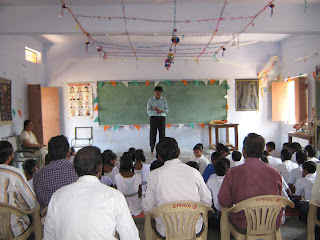 WISH YOU A HAPPY & PRSPOROUS NEW YEAR TO ALL VIEWERS.
WISH YOU A HAPPY & PRSPOROUS NEW YEAR TO ALL VIEWERS. WORK AS IF ON EASH OF YOU DEPENDED THE WHOLE WORK; FIFTY CENTURIES ARE LOOKING ON YOU. THE FUTURE OF INDIA DEPENDS ON YOU.- Swami Vivekanand. M.S.HARI/SECRETARY/CRDES.
CENTRE FOR RURAL DEVELOPMENT AND ENVIRONMENTAL STUDIES (CRDES) 20-46(102) Venkatapuram,Secunderabad-500 015 (REGD No>1273/2002)
 WISH YOU A HAPPY & PRSPOROUS NEW YEAR TO ALL VIEWERS.
WISH YOU A HAPPY & PRSPOROUS NEW YEAR TO ALL VIEWERS. 
|
||||||||||||||||||||||

A 600 MW solar power park, touted as Asia's first and largest, was on Thursday dedicated to the nation by Gujarat Chief Minister Narendra Modi in the state's Patan district, in a boost to India's efforts towards low carbon growth.
The solar power park with a power generation capacity of 600 MW, covering approximately 3,000 acres of wasteland bordering the Rann of Kutch, will generate two-thirds of India's total 900 MW of solar power production.
"Gujarat dedicates 600 MW of solar power to the nation on Thursday. We are celebrating the launch of Agni V & dedication of 600 MW solar power park in Gujarat," Modi said on micro blogging site twitter.
According to the Gujarat government, the solar project will lead to a reduction in carbon dioxide emissions to the tune of eight million tonnes and save 900,000 tonnes of natural gas annually.
Under its Solar Power Policy, the state government had signed memorandums of understanding for generation of 968.5 MW of solar power by the end of this year.
Other projects will be developed at Anand, Banaskantha, Jamnangar, Junagadh, Kutch, Porbandar, Rajkot, Surat and Surendranagar.
The Gujarat Solar Park is an innovative concept of the state government to promote solar installations in which it allocated developed land to the project developers with the entire infrastructure, including power evacuation, roads and water for commissioning of the power project put on fast track.
Gujarat will also host the 'India Solar Summit 2012: Investment and Technology Expo' in Gandhinagar April 20 and 21.
NEW DELHI: A report commissioned by the government has recommended that 34 dams on the Alaknanda and Bhagirathi rivers - the two main tributaries of the Ganga - should not be allowed to come up as they will cause irrevocable harm to biodiversity in Uttarakhand.
Prepared by the Wildlife Institute of India (WII), the report flashes a red light with regard to the hydroelectric projects that add up to 2,600 MW and make for about a tenth of all small and big dams on the anvil in the state.
The report, prepared at the behest of the environment ministry, also recommends maintenance of a minimum ecological flow at different points along river stretches that can impact production of power from other dams. If the suggestion is accepted, these power projects will have to function at a lower than planned production level.
The report comes ahead of a meeting of the National Ganga River Basin Authority (NGRBA), to be chaired by Prime Minister Manmohan Singh on Tuesday. The meeting was called after G D Agarwal, earlier a member secretary of the Central Pollution Control Board and a professor at IIT Kanpur, went on fast to demand dams in Uttarakhand be stopped and the river be allowed to flow freely.
The big projects in the "red list" include the 530 MW Kotlibhel II, the 250 MW Tamak Lata on Dhauli Ganga, the 320 MW Kotlibhel IB on Alaknanda, the 381 MW Bharon Ghati and the195 MW Kotlibhel IA on Bhagirathi. The WII report notes, "The scenarios (with the 34 dams being excluded) also provide adequate basis...to applying an 'exclusion approach' across the two basins for securing key biodiversity values."
Stopping the dams, the report says, is important to safeguard "critically important habitats and designated protected areas". While WII has not used words like "stop" and "rollback", its uses of the term "excluded" is intended to signal that it will opt for conserving biodiversity over power production goals.
The debate within government and among activists has been raging for almost two years with some asking that all projects be halted till a cumulative assessment is undertaken. Earlier, the 'holy' nature of the river was evoked by the government to stop some upcoming dams, while invoking the fiscal imperative to continue projects that are heavily invested in.
The meeting on Tuesday has been preceded by state officers as well as the Union environment minister Jayanthi Natarajan meeting PMO brass separately over the past two days. The PM is expected to hold the meeting on Tuesday with some of Agarwal's team members expected to be present as special invitees.




 CRDES conducted One day work shop on VEDIC MATHS at ZPHSchool of GANGARAM Village 50 Selected Students and 9 teachers of 7 schools of Kondapur Mandal were present. Sri.Ramireddy ,DGM of BDL conducted the workshop. Smt.Vasanta, HM of ZPHS, Rudraram arranged the programme and felicitated the faculty. Local Presinent of CRDES branch Sri.Anand and the Secretary Sri.Chandrasekhar and members arranged the Lunch to the participated teachers and the visitors.Sri.M.S.HARI.General Secretary of CRDES and Sri.Shantamurthy,JWM/OFD ,and the President of OFD,CRDES branch attended the workshop.
CRDES conducted One day work shop on VEDIC MATHS at ZPHSchool of GANGARAM Village 50 Selected Students and 9 teachers of 7 schools of Kondapur Mandal were present. Sri.Ramireddy ,DGM of BDL conducted the workshop. Smt.Vasanta, HM of ZPHS, Rudraram arranged the programme and felicitated the faculty. Local Presinent of CRDES branch Sri.Anand and the Secretary Sri.Chandrasekhar and members arranged the Lunch to the participated teachers and the visitors.Sri.M.S.HARI.General Secretary of CRDES and Sri.Shantamurthy,JWM/OFD ,and the President of OFD,CRDES branch attended the workshop.




